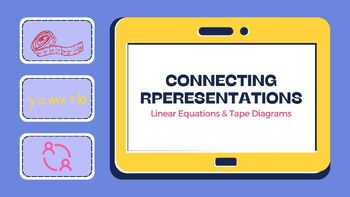Connecting Representations: Tape Diagram & Linear Equations (FULL BUNDLE)
KDS Education
1 Follower
Grade Levels
6th - 7th
Subjects
Resource Type
Standards
CCSS7.EE.B.4
CCSS7.EE.B.4a
CCSSMP2
CCSSMP4
CCSSMP6
Formats Included
- Zip
KDS Education
1 Follower
Products in this Bundle (4)
Description
The connecting representations math routine is guaranteed to support your learners in making connections between multiple representations in math.
This slideshow, lesson plan, and worksheet are companions in this Connecting Representations routine. This routine allows students to make the connection between tape diagrams and equations. This lesson explicitly supports students ability to model algebraic equations written in y=mx+b form and y=A(x+B). This lesson can be used as an introduction to tape diagrams that support students in not only modeling algebraic scenarios but also solving algebraic equations.
Implementation Recommendations
- If this is the first time using the connecting representations routine, plan for this lesson to take up to 1 hour.
- Make use of a visible timer during silent observation and partner sharing to keep students on task.
- After a pair shares a connection at the board, call on volunteers to recall what the pair shared to reinforce learning.
- Provide a designated pointing tool or ruler to pointers sharing at the board.
- Circulate while students are creating representations to assess and extend their learning.
- If time permits Use a document camera to share the representations that students create.
Total Pages
Answer Key
N/A
Teaching Duration
N/A
Report this resource to TPT
Reported resources will be reviewed by our team. Report this resource to let us know if this resource violates TPT’s content guidelines.
Standards
to see state-specific standards (only available in the US).
CCSS7.EE.B.4
Use variables to represent quantities in a real-world or mathematical problem, and construct simple equations and inequalities to solve problems by reasoning about the quantities.
CCSS7.EE.B.4a
Solve word problems leading to equations of the form 𝘱𝘹 + 𝘲 = 𝘳 and 𝘱(𝘹 + 𝘲) = 𝘳, where 𝘱, 𝘲, and 𝘳 are specific rational numbers. Solve equations of these forms fluently. Compare an algebraic solution to an arithmetic solution, identifying the sequence of the operations used in each approach. For example, the perimeter of a rectangle is 54 cm. Its length is 6 cm. What is its width?
CCSSMP2
Reason abstractly and quantitatively. Mathematically proficient students make sense of quantities and their relationships in problem situations. They bring two complementary abilities to bear on problems involving quantitative relationships: the ability to decontextualize-to abstract a given situation and represent it symbolically and manipulate the representing symbols as if they have a life of their own, without necessarily attending to their referents-and the ability to contextualize, to pause as needed during the manipulation process in order to probe into the referents for the symbols involved. Quantitative reasoning entails habits of creating a coherent representation of the problem at hand; considering the units involved; attending to the meaning of quantities, not just how to compute them; and knowing and flexibly using different properties of operations and objects.
CCSSMP4
Model with mathematics. Mathematically proficient students can apply the mathematics they know to solve problems arising in everyday life, society, and the workplace. In early grades, this might be as simple as writing an addition equation to describe a situation. In middle grades, a student might apply proportional reasoning to plan a school event or analyze a problem in the community. By high school, a student might use geometry to solve a design problem or use a function to describe how one quantity of interest depends on another. Mathematically proficient students who can apply what they know are comfortable making assumptions and approximations to simplify a complicated situation, realizing that these may need revision later. They are able to identify important quantities in a practical situation and map their relationships using such tools as diagrams, two-way tables, graphs, flowcharts and formulas. They can analyze those relationships mathematically to draw conclusions. They routinely interpret their mathematical results in the context of the situation and reflect on whether the results make sense, possibly improving the model if it has not served its purpose.
CCSSMP6
Attend to precision. Mathematically proficient students try to communicate precisely to others. They try to use clear definitions in discussion with others and in their own reasoning. They state the meaning of the symbols they choose, including using the equal sign consistently and appropriately. They are careful about specifying units of measure, and labeling axes to clarify the correspondence with quantities in a problem. They calculate accurately and efficiently, express numerical answers with a degree of precision appropriate for the problem context. In the elementary grades, students give carefully formulated explanations to each other. By the time they reach high school they have learned to examine claims and make explicit use of definitions.




